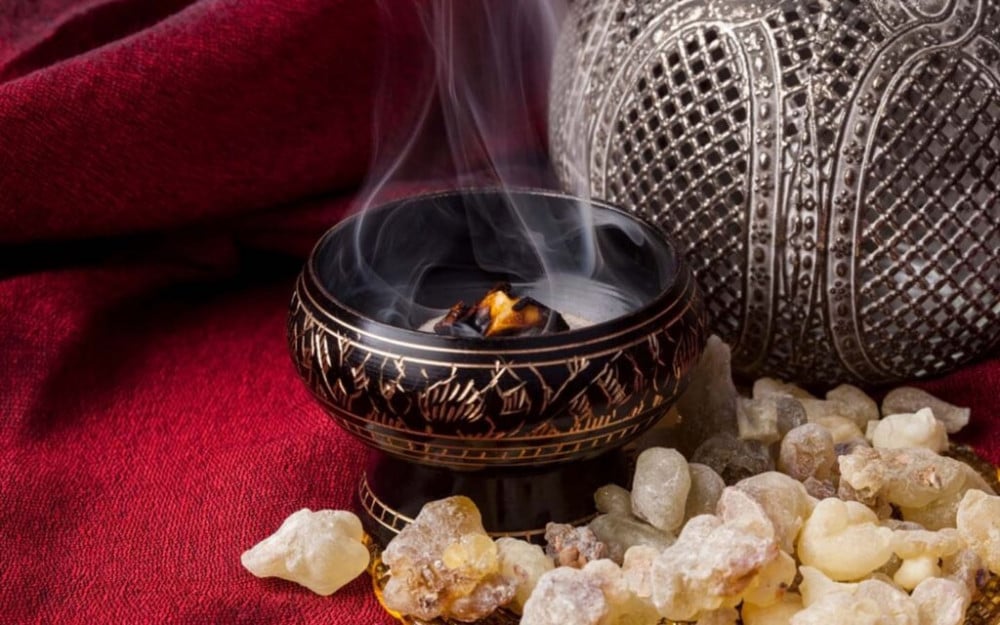incense
An aromatic biomaterial that releases an aromatic smoke when burned. The term is used to refer to the substance or scent. Incense is used for aesthetic, aromatherapy, meditation, and ceremonial reasons. It can also be used as a simple deodorant or insect repellent.
There are many forms and different mixtures in all regions of the world. In Arab countries, it is found in councils, but in Asian countries, it is used in temples.
Incense consists of aromatic plant materials, often mixed with essential oils . The forms that incense takes vary according to the local culture, and the way it is manufactured has changed with the advancement in technology and the rates of its use have increased.
Incense can generally be divided into two main types according to the method of use: “non-combustible incense” and “direct combustible incense”. Non-direct combustible incense is a type that is unable to burn on its own, and requires a continuous external heat source to burn. The direct combustion incense is ignited directly once by the flame and then fanned and extinguished, leaving a glowing ember that self-ignites and releases a smoky scent.
The method of extraction of oud is usually obtained from the finest types of oud wood, from perennial trees, whose age ranges between 150 and 70 years. Provided that the infection has developed since more than 60 years. The beginning of the extraction of this rare ingredient, is the harvesting and cutting process by cutting down the agarwood trees in the winter season and the dry season. This is done by extracting it from its roots, by experienced experts, by cutting down the tree and cutting off the affected parts. The traditional details follow:
1- Separate the infected parts from the uninfected ones. 2- Clean the affected parts, by using professional manpower and using a lot of carving equipment, and freeing the oud from the uninfected parts, and from some non-wooden parts attached to the oud, and this is done with care and patience. After cleaning, the polishing process begins, using what looks like a non-sharp notched file, as well as cloths, to obtain clean and shiny stick pieces. And reservation of waste to be used in the manufacture of Oudh.
Sorting process: Oud experts sort the wood according to the criteria of weight and color. As a result of the sorting process, a division takes the following order:
Double Super wood, which is black and heavy in weight, and is usually the best and most expensive type of agarwood. The best is the solid black, which resembles a rock, and is distinguished by the fact that it does not float on water, and fat does not drip from it.
The method of using oud or incense is usually in what is called the incense burner . In some Arab countries, such as Saudi Arabia , the Sultanate of Oman, the Emirates, Kuwait , Qatar , Bahrain and Jordan, passing incense to the guests in the majlis is a sign of good hospitality.
The scientific term for the agarwood tree is called (Equaloria), and it is the mother tree out of 15 trees found in the whole world, where most of the trees became extinct due to uprooting it to extract oil and incense. (Equaloria) This incense tree is between 70-100 years old.
The country of origin and the tropical, moist and abundantly rainy flavors that East Asia is famous for, especially Vietnam, Indonesia, India, Cambodia and Thailand. It grows at a very high speed, especially if a good climate is available, and its growth and completion reach within three years only.
Incense or artificial oud is now because of the high cost of natural and is manufactured in Indonesia and some countries. It is made of ordinary tree wood, which are not natural sticks. It is dyed black by means of thermal ovens and very hot sand, and oud oil is poured on it, so that if you light this oud, it gives you a light incense smell that foams as it comes. As heavy pieces, difficult to break or bend.
It is a derivative of incense and extracted as follows: 1- The wood is cut into very small pieces, and if the agarwood is semi-good, it is cut into small pieces and pounded with a large hammer, to turn into pulverized crumbs. Another method used in Thailand is grinding the agarwood with an electric mill, and turning it into powder.
2- Small pieces or powder are soaked in water for a period ranging from 5 to 30 days. During this period, the fermentation process takes place, which helps to convert a large part of the wax present in the agarwood into agarwood oil.

